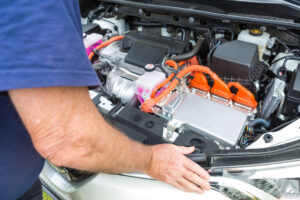
Electric vehicles (EV) continue to experience a rise in adoption and popularity. If you’ve only owned gas-powered vehicles, you might wonder what kind of maintenance an EV needs. Here are a few of the core maintenance requirements of EVs.
Instead of an internal combustion engine (ICE) that ignites fuel to create power, an EV uses a battery. So, your EV will not need an oil change. Instead, you’ll need to maintain the battery pack, which is what provides power to the electric motor. This is simply checking the battery’s health and capacity to ensure that battery performance is satisfactory.
Most batteries should last 10-20 years, and every battery sold in the U.S. comes with a minimum eight year/100,000 mile warranty. So, while you do need to keep track of performance and take steps to promote longevity, battery maintenance is relatively easy.
Most EVs have an automatic single-gear transmission which needs to be lubricated. Transmission fluid should be checked regularly and flushed and replaced as needed.
ICE vehicles typically use a hydraulic system with disc or drum brakes. These types of conventional braking systems rely on friction (the brake pad pushing up against the drum or pinching the disc) to get the vehicle to stop. In this case, that energy is lost as heat.
In comparison, most EVs use regenerative braking, which allows the battery to recoup some of the energy spent as the vehicle slows. It essentially uses the wheels to turn the motor during deceleration. This system needs to be properly maintained as it can affect both the driver’s ability to stop as well as the engine’s ability to take advantage of the kinetic energy created during the braking process.
Regenerative braking systems still use brake pads as well as brake fluid, so owners of EVs should anticipate getting these items checked every five years or 100,000 miles.
Of course, tires for EVs are the same as tires for ICE engines. Wear and tear of tire treads should be monitored, and owners can use the penny test to confirm tread depth. EV owners should also check tire pressure with a gauge and complete a visual inspection for any punctures or uneven wear.
EVs use a special type of low conductivity coolant. EV coolant doesn’t have to do the heavy lifting that coolant in an ICE vehicle must of dispersing heat from the engine, but it’s still a good idea to check the level periodically. You might not ever need to replace the coolant, but with heavy usage of the vehicle there is the possibility of having to flush and replace the coolant every five years or 100,000 miles.
Most new EVs have fewer maintenance requirements than ICE vehicles. With a battery pack instead of an engine, oil changes are not needed, so the only other items are more longer-term maintenance or typical vehicle needs such as tire care.
Contact the any of our dealerships at Ontario Auto Center to learn about available EVs and any maintenance items owners can expect.
While great effort is made to ensure the accuracy of the information on this site, errors can occur. Please verify all pricing and installed equipment information with a customer service representative. This is easily done by calling us or visiting us at the dealership.
Customer may not qualify for ALL Rebates shown. Some rebates are stackable and others can and cannot be combined. See Dealer For Complete Details.
We improve our products and advertising by using Microsoft Clarity to see how you use our website. By using our site, you agree that we and Microsoft can collect and use this data. Our privacy statement has more details.